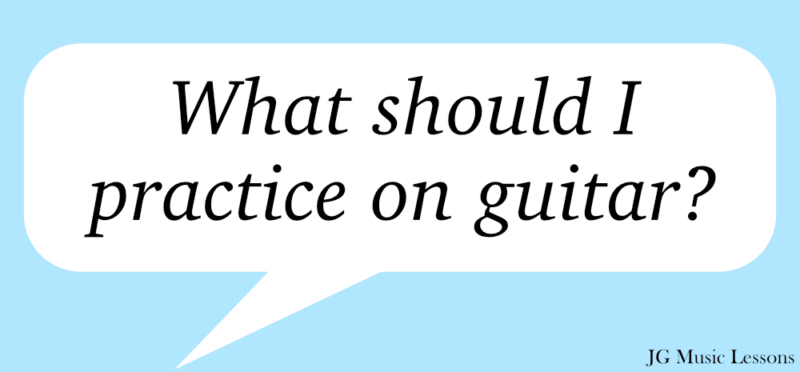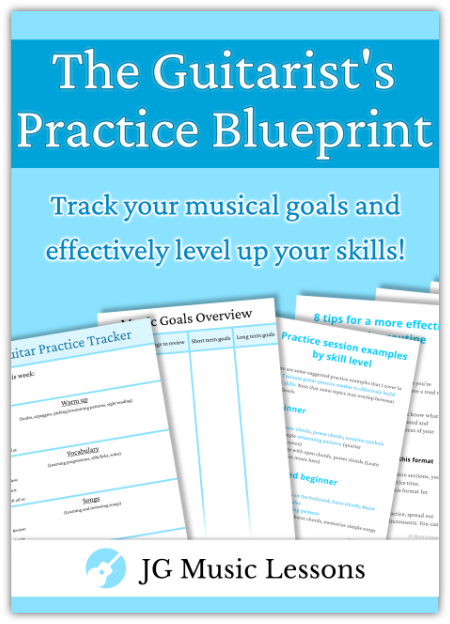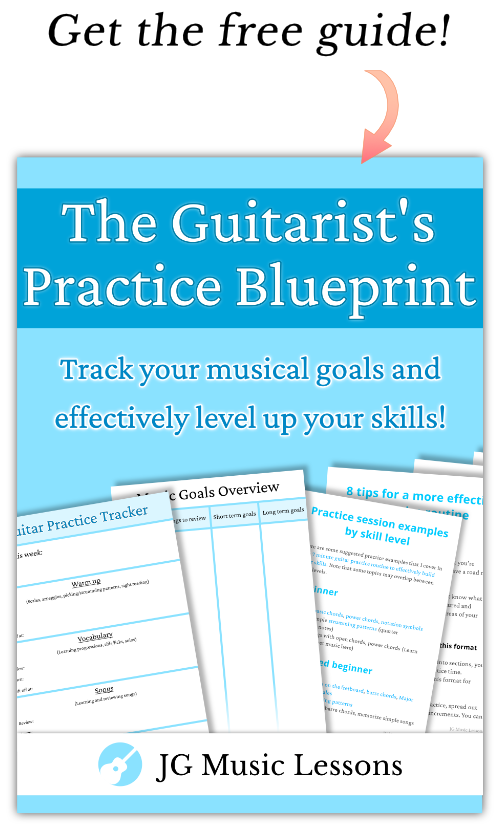If you aren’t sure what to practice on guitar or feel stuck in the learning process, this post will give you clarity on important areas that you can work to get better!
Although each person has a specific genre they prefer or musical goal they want to achieve, the musical concepts mentioned here can help you see the bigger picture of what to practice for effective results.
Keep in mind that these musical concepts don’t have to be done in a specific order but are simply different categories that you can focus on.
Let’s get started!
Chords
The first thing I suggest doing is learning your basic chords, also known as open chords. Open chords are chord shapes that include one or more open strings and are usually what every beginner starts with. These chords are your bread and butter that will help to play many popular songs in a relatively short amount of time.
After learning your open chords, you can learn power chords, which are built on 2 or 3 note movable shapes. Power chords are indicated by a number 5 next to the root (such as C5 or G5) and are more often used in a rock and pop context.
Here is an example of the same power chord shape shifted to different root notes on the 6th string.
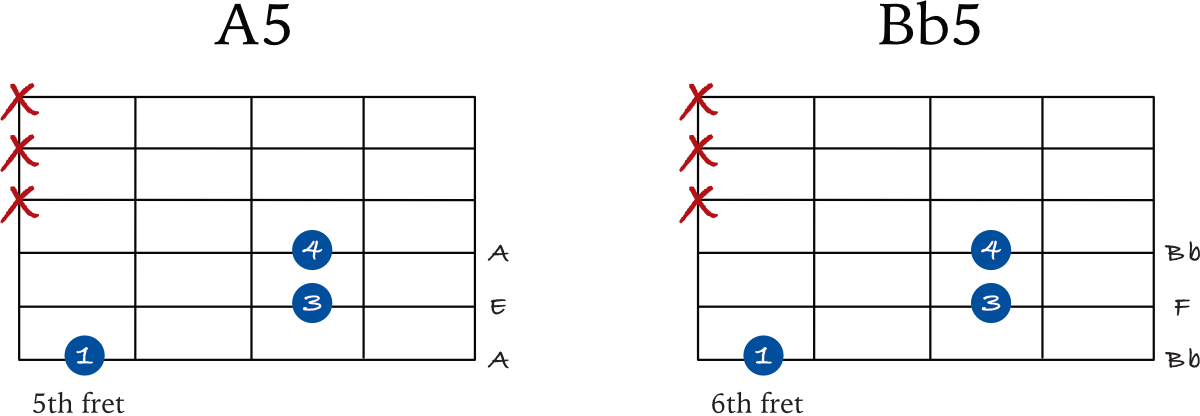
After learning open chords and power chords, the next step would be to learning to play barre chords, which allow you to play in any key. Barre chords are chords where one finger covers multiple strings. This can take some time to develop strength in your hand and fingers but are very useful once you get them down.
Barre chords are also movable, so once you learn the shape, you just have to find the root note of the chord you want to play. That being said, you want to be able to know all the notes on the fretboard so you can find any root note. Here are 7 tips to learn all of the notes on the guitar fretboard.
Here is an example of how you can use the same barre chord shape starting on different root notes.
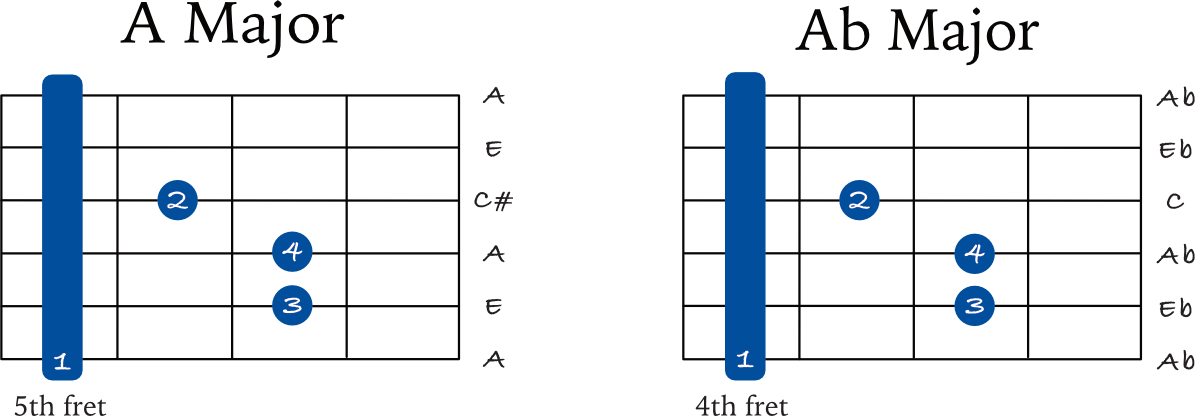
By learning barre chords, you can start to learn different ways a chord. For example, see 6 ways of play a Major chord on guitar.
Later on, you can explore more advanced concepts like slash chords, 7th chords, drop 2 chords or jazz chords.
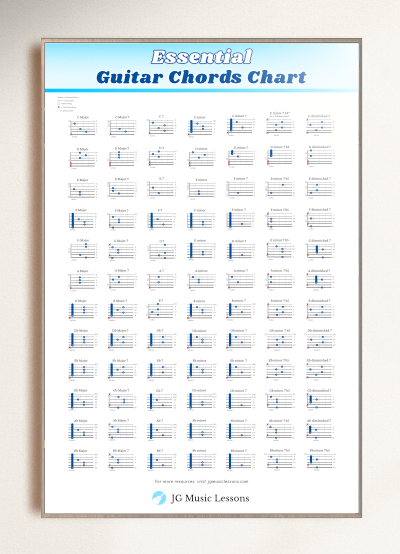
Strumming
As you continue to learn new chords, you have to be able to execute them through strumming. At first, I would learn some patterns in different time signatures as a guide which you can then adjust to your liking.
Strumming the guitar is a lot like thinking as a percussionist. You have to keep good time and create interesting, repetitive patterns with variations. I highly recommend practicing strumming using a metronome to improve your sense of time (here is a free metronome on the site). Always start at a slow and comfortable tempo and then gradually increase it when practicing.
Start with simple patterns using eighth notes, which include the beats and the ‘ands’ in between each beat.
For example,

Here is another example in a 6/8 time signature.

After learning some patterns in different time signatures, you can also learn patterns that include 16th notes. The duration of 16th notes is 1/4th of a quarter note or half of an eight note. We can count this as “1, e, and, a, 2, e, and, a, etc…
Here is an example of a strumming pattern with 16th notes in a 4/4 time signature.

Experiment with creating strumming patterns as you progress and also try to learn them from songs you like. If you want to learn more complex rhythms using a fingerpicking technique, check out how to play Bossa Nova rhythms on guitar.
Picking
Picking, as opposed to strumming, focuses on playing single strings at a time. Picking can be done to play the melody of a song or while you’re pressing down on a chord to arpeggiate (meaning to split up the notes of a chord individually).
The two main methods of picking are finger picking and using a pick. Some people like to use both methods, while others prefer to stick to one method that is more comfortable for them.
Whichever method you decide to use, the goal is to be able to play notes evenly when switching between strings. There are many patterns you can practice to improve your ability to get a clean and even sound.
If you don’t have much much experience playing single notes, you could work on basic technique builder exercises like this one that has 1, 2, 3, 4 pattern on the fretting hand.

Other technique builder patterns you can try are:
- 1, 2, 3
- 1, 3, 4
- 1, 2, 4
- 1, 3, 2, 4
- Any pattern but skipping a string.
However, It’s best to practice using a scale because it is a practical tool that you can use.
Here are some examples of different scale patterns in C Major.
3 consecutive note pattern
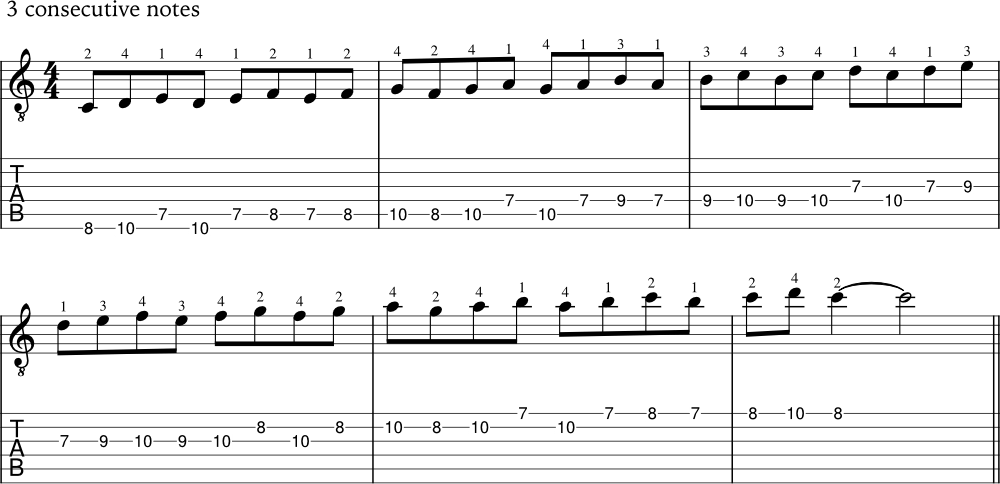
4 consecutive note pattern
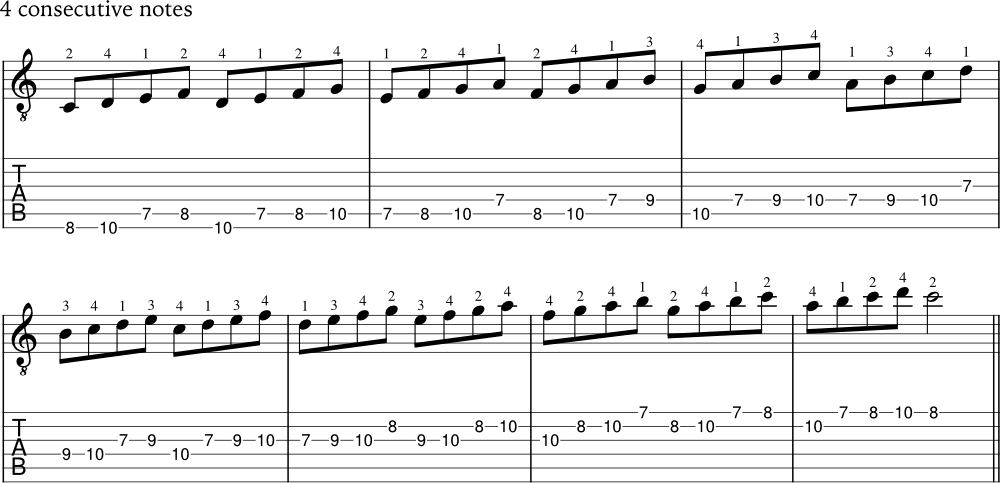
In thirds

You can also try to play these patterns in reverse by going from the 1st string to the 6th string. Once you get this down, try these exercises in different areas of the fretboard and also try it in different key signatures. For a more examples, I recommend this lesson on how to practice scales on guitar.
Again, using a metronome will be very helpful to develop good timing and technique. Like I mentioned with strumming, start at a slow, comfortable tempo and gradually increase it.
Related resource:
7 ways to get better at finger picking on guitar.
Learn songs
Learning songs will develop all aspects of your playing like improving your rhythm, understanding what chords work well together, and how to connect a melody and chords. Whether you learn the chord progression or melody to a song you like, this will help you develop your skills and give you more musical ideas.
It’s important to learn songs because ultimately, we want to be able to play and make music, not just know the technicalities of the instrument.
Learning songs can create a sort of sound library that you can refer back to. Over time, it becomes easier and natural to create chord progressions and melodies because you’ve built a memory bank from all of the songs that you tried to learn.
To practice songs, you can check out the sheet music with tabs resource on the site.
Learn music theory
Learning music theory can seem overwhelming at first but once you take some time to learn it, musical concepts will start to make sense and how you can apply it in your playing.
Music theory includes things like learning key signatures, scales, chord theory, intervals, and understanding chord progressions.
I encourage you to take the music theory material you’re learning and always try to apply it to the guitar. The goal is to become familiar and comfortable moving around the fretboard once you understand the theory behind a musical concept.
For example, a powerful concept to understand and be able to play on guitar is triads. Triads refer to chords that are built from the 1st, 3rd, and 5th of a scale, also known as chord tones.
Here are some different chord qualities and the scale notes included in each of them. You can click on the links listed below to learn different ways of playing them on guitar.
| Chord quality | Chord tones |
|---|---|
| Major chord | 1, 3, 5 |
| Minor chord | 1, b3, 5 |
| Diminished chord | 1, b3, b5 |
| Augmented chord | 1, 3, #5 |
Here is an example of how to play an E Major triad in 3 octaves across the fretboard. E Major triad has the notes E, G#, and B.

Here is an example of how to play an E minor triad in 3 octaves across the fretboard. E minor triad has the notes E, G, and B.

Here is an example of how to play an E diminished triad in 3 octaves across the fretboard. E diminished triad has the notes E, G, and Bb.

Transcribing
Transcribing is being able to pick up the music you hear and preferably write it down so that you can analyze and learn from the material.
If you’re a beginner, you probably want to try focusing on the previous areas we covered here first to develop your fundamentals and then get into transcribing as you progress later on.
Transcribing requires ear training and understanding of basic theory to get the most out of this practice. You can transcribe to help you to learn and analyze chord progressions or learn solos that will help you in improvisation.
You may find this post helpful: How to develop ear training to play what you hear.
Recording yourself

Recording yourself will help you to more objectively hear how you’re playing. Sometimes we don’t realize how we’re sounding while playing but when you listen to yourself on a recording, it gives you a different perspective.
While it can be easy to be over critical of your playing, use recording as a reference to what you want to develop but also to hear what is working already.
Recording can not only be really fun but also a source of very effective practice depending on how you use it. You can check out these 6 benefits of recording to practice music.
If you use a Mac, you can use a free recording software program like Garageband. If you want to get a more advanced software program for Mac, I would recommend getting Logic Pro. If you want to try it out, here is a link to a free 90 day trial (not an affiliate link).
Listening
Listening is crucial to developing your musicianship. The more intentional we are about listening to music, the more natural it becomes to express ourselves on the instrument and what things should sound like.
As you expose yourself to good music, you are subconsciously picking up on different patterns and ideas that can develop your sense of musicality.
We have so much music readily available to us on different platforms online. For example, you can start to make a playlist of your favorite music on Youtube or Spotify which you want to learn. Listening is something you can easily incorporate on your way to school or work and can inspire you at the start of your day.
Wrapping up
If you want to get out of a plateau in the guitar learning process, you can review the different music concepts covered here to reset your practice approach. As you stick to reviewing and learning new material consistently, you will start to see the results in your guitar playing.
There is no one size fits all or perfect way to practice on guitar so seek out the areas you want to improve on and see what works best for you. You may also want to check out these 6 tips to improve your guitar playing.
I also created a 7 minute practice routine to help you practice guitar more efficiently in less time. The idea is to make a goal of what you want to improve on in key areas and split up the time to develop them in your practice session.
📘 Get the free guitar practice guide here!
All the best,
JG Music Lessons
📙 Kickstart your guitar playing with our step by step guide: Guitar Essentials.
🎸 Looking for a travel or half-sized guitar? See this one.
🛠 See our other music recommendations.
🤝 Support the site to help us to create better content for you!
Level up with the FREE guitar practice guide and effectively improve your playing! 🎸
Get it sent to your email!

